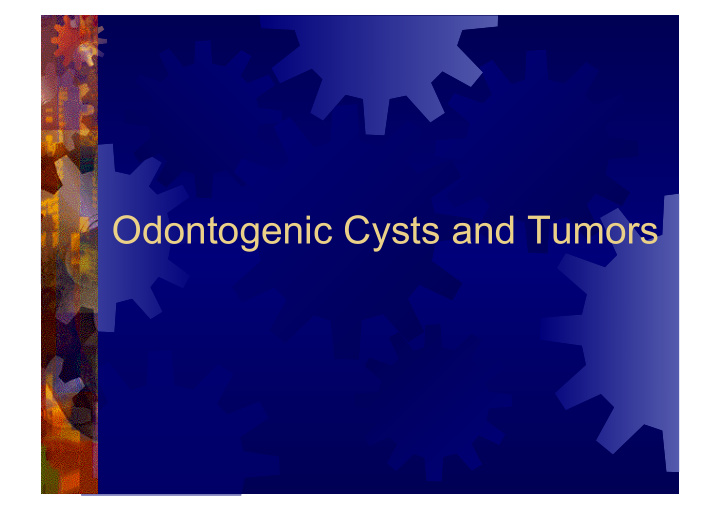



Odontogenic Cysts and Tumors
Introduction Variety of cysts and tumors Uniquely derived from tissues of developing teeth May present to otolaryngologist
Odontogenesis Projections of dental lamina into ectomesenchyme Layered cap (inner/outer enamel epithelium, stratum intermedium, stellate reticulum) Odontoblasts secrete dentin ameloblasts (from IEE) enamel Cementoblasts cementum Fibroblasts periodontal membrane
Odontogenesis
Diagnosis Complete history Pain, loose teeth, occlusion, swellings, dysthesias, delayed tooth eruption Thorough physical examination Inspection, palpation, percussion, auscultation Plain radiographs Panorex, dental radiographs CT for larger, aggressive lesions
Diagnosis Differential diagnosis Obtain tissue FNA – r/o vascular lesions, inflammatory Excisional biopsy – smaller cysts, unilocular tumors Incisional biopsy – larger lesions prior to definitive therapy
Odontogenic Cysts Inflammatory Developmental Radicular Dentigerous Paradental Developmental lateral periodontal Odontogenic keratocyst Glandular odontogenic
Radicular (Periapical) Cyst Most common (65%) Epithelial cell rests of Malassez Response to inflammation Radiographic findings Pulpless, nonvital tooth Small well-defined periapical radiolucency Histology Treatment – extraction, root canal
Radicular Cyst
Radicular Cyst
Residual Cyst
Paradental Cyst Associated with partially impacted 3 rd molars Result of inflammation of the gingiva over an erupting molar 0.5 to 4% of cysts Radiology – radiolucency in apical portion of the root Treatment – enucleation
Paradental Cyst
Dentigerous (follicular) Cyst Most common developmental cyst (24%) Fluid between reduced enamel epithelium and tooth crown Radiographic findings Unilocular radiolucency with well-defined sclerotic margins Histology Nonkeratinizing squamous epithelium Treatment – enucleation, decompression
Dentigerous Cyst
Dentigerous Cyst
Developmental Lateral Periodontal Cyst From epithelial rests in periodontal ligament vs. primordial cyst – tooth bud Mandibular premolar region Middle-aged men Radiographic findings Interradicular radiolucency, well-defined margins Histology Nonkeratinizing stratified squamous or cuboidal epithelium Treatment – enucleation, curettage with preservation of adjacent teeth
Developmental Lateral Periodontal Cyst
Odontogenic Keratocyst 11% of jaw cysts May mimic any of the other cysts Most often in mandibular ramus and angle Radiographically Well-marginated, radiolucency Pericoronal, inter-radicular, or pericoronal Multilocular
Odontogenic Keratocyst
Odontogenic Keratocyst
Odontogenic Keratocyst Histology Thin epithelial lining with underlying connective tissue (collagen and epithelial nests) Secondary inflammation may mask features High frequency of recurrence (up to 62%) Complete removal difficult and satellite cysts can be left behind
Odontogenic Keratocyst
Treatment of OKC Depends on extent of lesion Small – simple enucleation, complete removal of cyst wall Larger – enucleation with/without peripheral ostectomy Bataineh,et al, promote complete resection with 1 cm bony margins (if extension through cortex, overlying soft tissues excised) Long term follow-up required (5-10 years)
Glandular Odontogenic Cyst More recently described (45 cases) Gardner, 1988 Mandible (87%), usually anterior Very slow progressive growth (CC: swelling, pain [40%]) Radiographic findings Unilocular or multilocular radiolucency
Glandular Odontogenic Cyst
Glandular Odontogenic Cyst Histology Stratified epithelium Cuboidal, ciliated surface lining cells Polycystic with secretory and epithelial elements
Treatment of GOC Considerable recurrence potential 25% after enucleation or curettage Marginal resection suggested for larger lesions or involvement of posterior maxilla Warrants close follow-up
Nonodontogenic Cysts Incisive Canal Cyst Stafne Bone Cyst Traumatic Bone Cyst Surgical Ciliated Cyst (of Maxilla)
Incisive Canal Cyst Derived from epithelial remnants of the nasopalatine duct (incisive canal) 4 th to 6 th decades Palatal swelling common, asymptomatic Radiographic findings Well-delineated oval radiolucency between maxillary incisors, root resorption occasional Histology Cyst lined by stratified squamous or respiratory epithelium or both
Incisive Canal Cyst
Incisive Canal Cyst Treatment consists of surgical enucleation or periodic radiographs Progressive enlargement requires surgical intervention
Stafne Bone Cyst Submandibular salivary gland depression Incidental finding, not a true cyst Radiographs – small, circular, corticated radiolucency below mandibular canal Histology – normal salivary tissue Treatment – routine follow up
Stafne Bone Cyst
Traumatic Bone Cyst Empty or fluid filled cavity associated with jaw trauma (50%) Radiographic findings Radiolucency, most commonly in body or anterior portion of mandible Histology – thin membrane of fibrous granulation Treatment – exploratory surgery may expedite healing
Traumatic Bone Cyst
Surgical Ciliated Cyst May occur following Caldwell-Luc Trapped fragments of sinus epithelium that undergo benign proliferation Radiographic findings Unilocular radiolucency in maxilla Histology Lining of pseudostratified columnar ciliated Treatment - enucleation
Surgical Ciliated Cyst
Odontogenic Tumors Ameloblastoma Squamous Odontogenic Tumor Calcifying Epithelial Odontogenic Tumor Calcifying Odontogenic Cyst Adenomatoid Odontogenic Tumor
Ameloblastoma Most common odontogenic tumor Benign, but locally invasive Clinically and histologically similar to BCCa 4 th and 5 th decades Occasionally arise from dentigerous cysts Subtypes – multicystic (86%), unicystic (13%), and peripheral (extraosseous – 1%)
Ameloblastoma Radiographic findings Classic – multilocular radiolucency of posterior mandible Well-circumscribed, soap-bubble Unilocular – often confused with odontogenic cysts Root resorption – associated with malignancy
Ameloblastoma
Ameloblastoma Histology Two patterns – plexiform and follicular (no bearing on prognosis) Classic – sheets and islands of tumor cells, outer rim of ameloblasts is polarized away from basement membrane Center looks like stellate reticulum Squamous differentiation (1%) – Diagnosed as ameloblastic carcinoma
Ameloblastoma
Treatment of Ameloblastoma According to growth characteristics and type Unicystic Complete removal Peripheral ostectomies if extension through cyst wall Classic infiltrative (aggressive) Mandibular – adequate normal bone around margins of resection Maxillary – more aggressive surgery, 1.5 cm margins Ameloblastic carcinoma Radical surgical resection (like SCCa) Neck dissection for LAN
Calcifying Epithelial Odontogenic Tumor a.k.a. Pindborg tumor Aggressive tumor of epithelial derivation Impacted tooth, mandible body/ramus Chief sign – cortical expansion Pain not normally a complaint
Calcifying Epithelial Odontogenic Tumor Radiographic findings Expanded cortices in all dimensions Radiolucent; poorly defined, noncorticated borders Unilocular, multilocular, or “moth-eaten” “Driven-snow” appearance from multiple radiopaque foci Root divergence/resorption; impacted tooth
Calcifying Epithelial Odontogenic Tumor
Calcifying Epithelial Odontogenic Tumor Histology Islands of eosinophilic epithelial cells Cells infiltrate bony trabeculae Nuclear hyperchromatism and pleomorphism Psammoma-like calcifications (Liesegang rings)
Calcifying Epithelial Odontogenic Tumor
Treatment of CEOT Behaves like ameloblastoma Smaller recurrence rates En bloc resection, hemimandibulectomy partial maxillectomy suggested
Adenomatoid Odontogenic Tumor Associated with the crown of an impacted anterior tooth Painless expansion Radiographic findings Well-defined expansile radiolucency Root divergence, calcified flecks (“target”) Histology Thick fibrous capsule, clusters of spindle cells, columnar cells (rosettes, ductal) throughout Treatment – enucleation, recurrence is rare
Adenomatoid Odontogenic Tumor
Recommend
More recommend